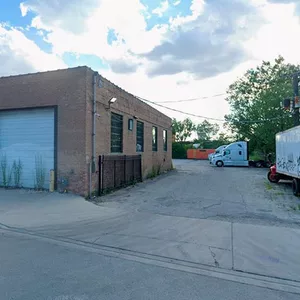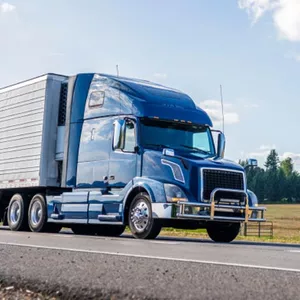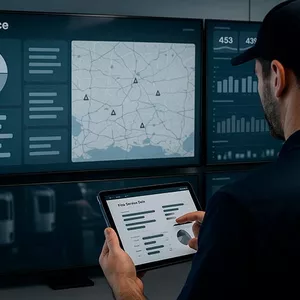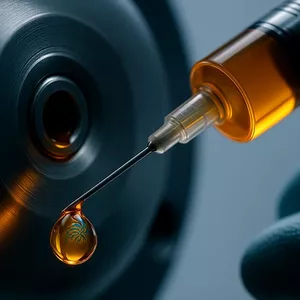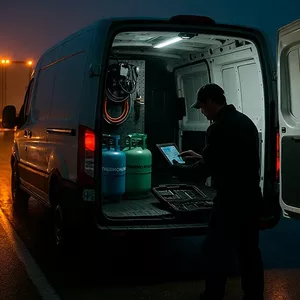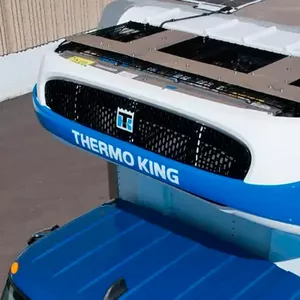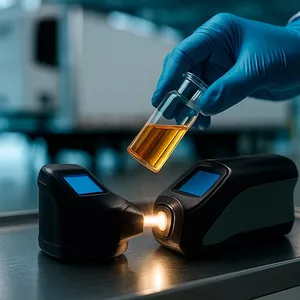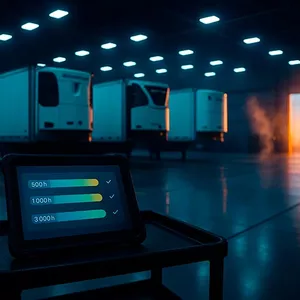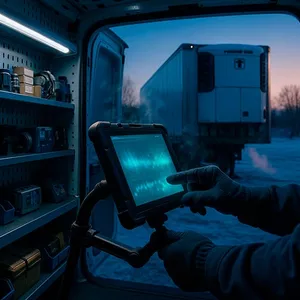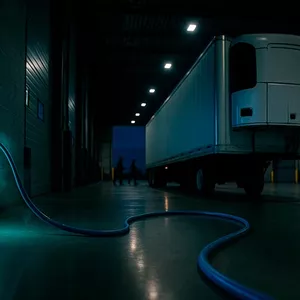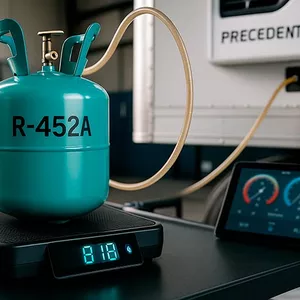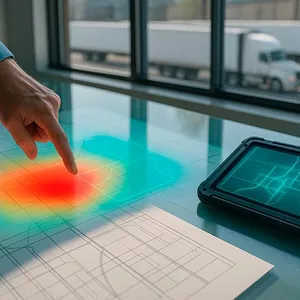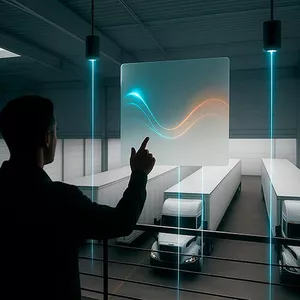Thermo King refrigeration systems move a significant share of temperature-sensitive freight through Chicago every day. When a unit loses efficiency or throws an error in the middle of a load, minutes matter—produce wilts, pharmaceuticals drift out of range, and schedules collapse. Our Thermo King-certified team exists for exactly that moment. Working from strategically placed mobile bays and a fully equipped South-Side facility, we handle urgent calls from single-trailer owner-operators, regional carriers, and national fleets with equal speed. Every repair request enters a dispatch matrix that cross-references the reported symptom, the unit’s model (SB-230, SB-330, SR-2, or Precedent), and its current location on the I-55, I-90, or local Chicago grid. The result is a technician who arrives already briefed on the unit’s firmware generation, common fault history, and the weather-related stress factors likely to affect cooling performance that day.
Thermo King Expertise Built for Chicago Logistics
Chicago’s stop-and-go traffic, lake-effect humidity, and rapid temperature swings create operating conditions unlike any desert or coastal corridor. Compressor head pressures spike during summer staging on the Dan Ryan; filter gelling appears in January when overnight temps crater on the Tri-State. Over two decades of localized service data guide every inspection we perform. Field engineers log discharge-line delta-T, alternator ripple voltage, and fuel vacuum readings on tablets that sync nightly with our central diagnostic database. Patterns surface quickly: SR-2 controllers on early SB-330 builds tend to drift four degrees after 18 000 hours; brushless alternators on 2016 Precedent units drop below 13.2 V under simultaneous clutch and heater demand. By intercepting these trends, we prevent the mid-run shutdowns that spark frantic “Thermo King repair near me” searches at 2 a.m.
- SB Series — SB-230, SB-310, SB-330, known for mechanical robustness but sensitive to fuel restriction.
- Precedent Series — S-600, S-700, C-600, featuring SMART Reefer SR-3 electronics and variable-speed fans.
- SmartReefer Legacy — SR-2 generations retrofitted with emissions updates and microprocessor boards.
Each platform demands unique sensor baselines, lubrication schedules, and clutch-gap tolerances. Our technicians maintain model-specific torque charts and firmware archives down to the patch level, allowing them to flash or roll back software in field conditions without risking data corruption.
Diagnostic Precision for Thermo King Electronics
Thermo King units fold mechanical, electrical, and control-logic variables into a single performance envelope. A cooling complaint that looks like low refrigerant may trace back to sensor drift or alternator ripple. Our diagnostic protocol begins with an SR controller image capture, saving active codes, configuration files, and 30-minute trend graphs. Next comes a live sweep of suction and discharge pressure, verified against a pressure-temperature chart corrected for Chicago barometric averages. If those values align, we track blower amperage and fuel draw. Because the fuel system and electrical subsystem talk to the same control logic, a slight voltage sag during burner-assist cycles can mimic evaporator choke and trigger code 89 in SR-2 units. Resolving the symptom without touching the root cause guarantees a repeat failure on the inbound leg. By isolating each variable—mechanical, electrical, logical—we fix the failure once, not three times.
Service Formats Tailored to Fleet Scenarios
- Mobile Emergency Repair — 24/7 dispatch covers the entire Chicagoland expressway network, bringing refrigerant recovery, nitrogen test rigs, and SR-series programming tools directly to the breakdown site.
- In-Shop Overhaul — Deeper projects—compressor change-outs, alternator retrofits, wire-harness rebuilds—take place in our heated bays with calibrated lifting jigs and reclaim stations.
Mobile crews travel with EPA-compliant recovery cylinders, on-board diesel gensets, and battery-backed laptops carrying the full Thermo King diagnostic suite. They can reseat a leaking discharge flange, prime an air-locked fuel system, or re-flash controller firmware in a truck stop parking lot without violating safety or environmental standards. In-shop work adds laser-aligned pullers for front-seal replacement and a climate-controlled chamber for final verification at −20 °F setpoints. Whether you need a quick alternator swap on I-294 or a scheduled 3 000-hour preventive service, the format scales to the urgency of your operation.
SB-330 and SR-2: High-Volume Field Cases
The SB-330 dominates Chicago’s short-haul produce and meat lanes, logging thousands of compressor starts per week. The most common SB-330 complaint we track is intermittent low-speed shutdown tied to fuel restriction at the pre-filter head. Our technicians bypass the pre-filter during diagnostics, log vacuum recovery time, and dissect the removed filter for paraffin buildup—an indicator of poor winterization. SR-2 controllers introduce another layer: if a driver resets the code without clearing trapped air, the controller counts successive fails and enters a no-start lockout. Field techs carry sealed prime bulbs and torque-spec filter caps to restore fuel pressure within fifteen minutes, then clear the SR-2 lock table so the load can finish the run.
Older SB-230 units raise separate issues: micro-fissures in solder joints cause phantom voltage on the sensor bus, leading to false high-temperature warnings. We resolve this with a board-level reflow under magnification, a step most general truck shops skip in favor of controller replacement. For fleet managers, that difference represents thousands of dollars saved over the service life of the unit.
Preventive Maintenance Philosophy
Reactive repair keeps freight moving; preventive maintenance keeps profit margins intact. Our PM checklist aligns with Thermo King’s official intervals but adds Chicago-specific modifiers. Fuel filters shift from 1 000 to 750 hours during peak winter to counter high-wax Midwest blends. Alternator belt tension is checked every 500 hours instead of 750 because salt spray accelerates bushing wear. Every service log includes bar-coded oil analyses: iron counts flag early bearing wear, silicone traces suggest intake leak paths, and fuel dilution points to injector imbalance. By trending these metrics alongside engine hours and ambient history, we predict failures before a dispatcher ever hears “unit not cooling.” The outcome is fewer emergency calls, lower loss claims, and longer engine life.
Frequently Asked Operational Questions
Q: Why does my SR-2 controller show code 89 even after a refrigerant top-off?
A: Code 89 often results from alternator ripple or sensor bus noise, not refrigerant level. Our diagnostic routine verifies electrical stability before adjusting charge.
Q: How fast can a mobile technician reach a stalled trailer inside Chicago city limits?
A: Average arrival is forty minutes during off-peak traffic and sixty during rush hour. We stage crews on the Eisenhower and Bishop Ford corridors to cut response time.
Q: Is refrigerant recovery always required for compressor replacement?
A: Yes. EPA Section 608 mandates full recovery. Our mobile rigs carry 50-pound DOT cylinders and electronic scales for precise recharge afterward.
Request Service
Downtime costs more than repairs. If your Thermo King unit shows erratic temperatures, persistent alarms, or sudden shutdowns anywhere in the Chicago area, call our 24-hour dispatch desk. A Thermo King-certified technician equipped with model-specific parts, refrigerant recovery gear, and SR diagnostics will be on the way—ready to restore cooling integrity and keep your load on schedule.









